| Dipsosaurus | |
|---|---|
 | |
| Desert iguana (Dipsosaurus dorsalis) | |
| Scientific classification | |
| Kingdom: | Animalia |
| Phylum: | Chordata |
| Class: | Reptilia |
| Order: | Squamata |
| Suborder: | Iguania |
| Family: | Iguanidae |
| Genus: | Dipsosaurus Hallowell, 1854 |
| Dipsosaurus | |
|---|---|
 | |
| Desert iguana (Dipsosaurus dorsalis) | |
| Scientific classification | |
| Kingdom: | Animalia |
| Phylum: | Chordata |
| Class: | Reptilia |
| Order: | Squamata |
| Suborder: | Iguania |
| Family: | Iguanidae |
| Genus: | Dipsosaurus Hallowell, 1854 |
Currently, there are two described species in this genus. [1]

Hoplocercidae are a family of lizards native to the tropical forests, woodlands and savanna-like habitats of Central and South America. Alternatively they are recognized as a subfamily, Hoplocercinae. Nineteen species in three genera are described.
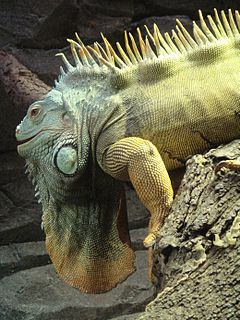
The Iguanidae are a family of lizards composed of iguanas and related species. This family consists of species such as the Green Iguana, the Lesser Antillean Iguana, and marine iguana, just to name a few.

The genus Brachylophus consists of four extant iguanid species native to the islands of Fiji and a giant extinct species from Tonga in the South West Pacific. One of the extant species, B. fasciatus, is also present on Tonga, where it has apparently been introduced by humans.
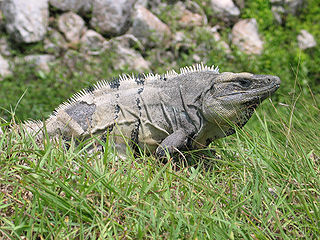
Ctenosaura is a lizard genus commonly known as spinytail iguanas or ctenosaurs. The genus is part of the large lizard family, Iguanidae and is native to Mexico and Central America. The name is derived from two Greek words: ctenos (κτενός), meaning "comb", and saura (σαύρα), meaning "lizard".
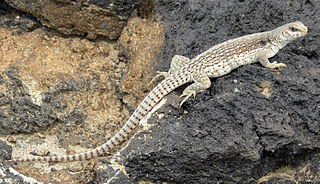
The desert iguana is an iguana species found in the Sonoran and Mojave Deserts of the Southwestern United States and northwestern Mexico, as well as on several Gulf of California islands.

The Lesser Antillean iguana is a large arboreal lizard endemic to the Lesser Antilles. It is one of three species of lizard of the genus Iguana and is in severe decline due to habitat destruction, introduced feral predators, hunting, and hybridization with its introduced sister species, the green iguana. Successful captive breeding of this species has been limited to only two instances, as most captive-laid eggs tend to be infertile.
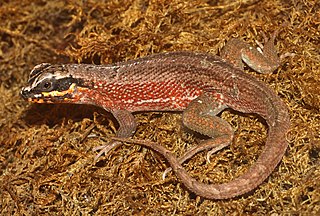
Iguania is an infraorder of squamate reptiles that includes iguanas, chameleons, agamids, and New World lizards like anoles and phrynosomatids. Using morphological features as a guide to evolutionary relationships, the Iguania are believed to form the sister group to the remainder of the Squamata, and comprise nearly 13,000 named species. However, molecular information has placed Iguania well within the Squamata as sister taxa to the Anguimorpha and closely related to snakes. The order has been under debate and revisions after being classified by Charles Lewis Camp in 1923 due to difficulties finding adequate synapomorphic morphological characteristics. Most Iguanias are arboreal but there are several terrestrial groups. They usually have primitive fleshy, non-prehensile tongues, although the tongue is highly modified in chameleons. The group has a fossil record that extends back to the Early Jurassic. Today they are scattered occurring in Madagascar, the Fiji and Friendly Islands and Western Hemisphere

Aridoamerica denotes an ecological region spanning Northern Mexico and the Southwestern United States, defined by the presence of the culturally significant staple foodstuff Phaseolus acutifolius, a drought-resistant bean. Its dry, arid climate and geography stand in contrast to the verdant Mesoamerica of present-day central Mexico into Central America to the south and east, and the higher, milder "island" of Oasisamerica to the north. Aridoamerica overlaps with both.

The Santa Catalina rattlesnake is a species of venomous pit viper endemic to Isla Santa Catalina in the Gulf of California just off the east coast of the state of Baja California Sur, Mexico. No subspecies are currently recognized. A relatively small and slender species, its most distinctive characteristic is that it lacks a rattle.

The rhinoceros iguana is an endangered species of iguana that is primarily found on the Caribbean island of Hispaniola. The largest of the Cyclura, they vary in length from 60 to 136 centimetres, and skin colours range from a steely grey to a dark green and even brown. Their name derives from the bony-plated pseudo-horn or outgrowth which resembles the horn of a rhinoceros on the iguana's snout.

Conolophus pallidus is a species of lizard in the family Iguanidae. It is one of three species in the genus Conolophus and is endemic to Santa Fe Island in the Galapagos.
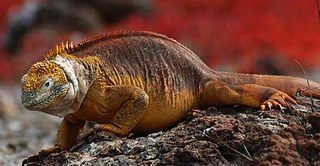
The Galápagos land iguana is a species of lizard in the family Iguanidae. It is one of three species of the genus Conolophus. It is endemic to the Galápagos Islands (Ecuador), in the dry lowlands of Fernandina, Isabela, Santa Cruz, North Seymour, Baltra, and South Plaza Islands.

Ctenosaura similis, commonly known as the common spiny-tailed iguana or black iguana, is a lizard native to Mexico, Central America, and some Colombian islands in the Caribbean Sea and Pacific Ocean. It has been introduced to the United States in the state of Florida. It is the largest species in the genus Ctenosaura.

Cyclura is a genus of lizards in the family Iguanidae. Member species of this genus are commonly known as "cycluras" or more commonly as rock iguanas and only occur on islands in the West Indies. Rock iguanas have a high degree of endemism, with in most cases a single species or subspecies restricted to an individual island.

Iguana is a genus of herbivorous lizards that are native to tropical areas of Mexico, Central America, South America, and the Caribbean. The genus was first described in 1768 by Austrian naturalist Josephus Nicolaus Laurenti in his book Specimen Medicum, Exhibens Synopsin Reptilium Emendatam cum Experimentis circa Venena. Two species are placed in the genus, the green iguana, which is widespread throughout its range and a popular pet, and the Lesser Antillean iguana, which is native to the Lesser Antilles. Genetic analysis indicates that the green iguana may comprise a complex of multiple species, some of which have been recently described, but the Reptile Database considers all of these as subspecies of the green iguana.
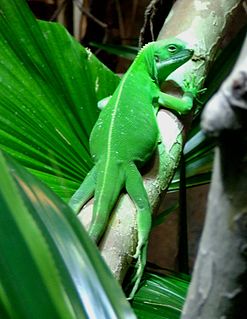
Brachylophus bulabula is a species of iguanid lizard endemic to some of the larger central and northwestern islands of Fiji, where it occurs in Fijian wet forest. It was described by a team led by a scientist from the Australian National University in 2008. It is one of the few species of iguana found outside of the New World and one of the most geographically isolated members of the family Iguanidae. Initially also reported from Gau Island, in 2017 this population was described as a separate species, B. gau.

Pumilia novaceki is an extinct iguanid that lived in what is now Palm Springs, California, from the Blancan to Irvingtonian stages of the Pliocene to Early Pleistocene.
Lepidosaur herbivory describes herbivorous lepidosaurs. Living non-avian reptiles form a paraphyletic group that consists of over 9,000 species of crocodiles, turtles, and lepidosaurs. The most diverse group, Lepidosauria, is first known from the Middle Triassic fossils, but likely originated in the Permian. Living lepidosaurs, which include snakes, lizards, and rhynchocephalians, occupy a wide range of environments and niches. The lepidosaurs have many similar anatomical morphology like transverse cloaca, distal tongue, superficial teeth attachment, fused pelvic bones etc. Though widely viewed as obligate carnivores, a small number of lepidosaurs are known to consume plant material. For example, there are roughly 3,300 species of living lizards and approximately 3% of them eat at least some plants. Though the exact definition of herbivory varies significantly between scientists, most define herbivorous lepidosaurs as those that consume plants for approximately 70-90% of its diet.

Isla San Luis, is an island in the Gulf of California east of the Baja California Peninsula. The island is uninhabited and is part of the Mexicali Municipality.
Dipsosaurus catalinensis, the Catalina desert iguana, is a species of lizard in the family Iguanidae. The species is native to Isla Santa Catalina in Mexico.